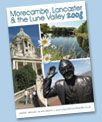Home / District Firsts - Finest, Oldest and Greatest
District Firsts - Finest, Oldest and Greatest
Morecambe Bay
Between Walney Island in Cumbria and Fleetwood in Lancashire is an area of 195 sq. mls. At extreme low tides 120 sq. mls. are exposed as a sandy desert. It is the largest intertidal area in Britain. The Bay is protected by so many European Designations that it ranks as the second most important Bay in the UK and the third most important in Europe.
Cedric Robinson is the proud, and only, holder in the UK of the title of Sand Pilot - officially the Queen's Guide to the Sands, an ancient honour dating back to the 14th century. He became the 25th royally-appointed Guide in 1963, since when he has successfully guided more than a third of a million people across the bay, an average of 10,000 a year. And in all those years, his salary as Queen's Guide has remained constant at a modest £15 a year, although he was awarded an MBE for his services on a rare visit to London in 1999.
History
Lancaster District has a total of 1,369 Listed Buildings, by far the highest number in the whole of Lancashire. The next is Ribble Valley with 824. Of the 1,369 there are 25 Grade One Listed Buildings, a ranking that means that the buildings are of national importance. There are 37 Conservation Areas and 38 Scheduled Monuments - again the highest in the County.
Nikolaus Pevsner, the famous architectural historian, described the Ashton Memorial in Lancaster's Williamson Park as "the grandest folly in England".
The Aqueduct carrying the Preston to Kendal Canal over the River Lune and the A683 is generally regarded as one of the greatest feats of canal engineering in the country, combining great strength with great elegance. The architect was John Rennie and the engineer was Alexander Stephens.
Castle Stede motte and bailey castle at Hornby is the finest example in Lancashire.
Lancaster Castle is one of the longest serving, if not the longest, operational prisons in Europe. Apart from several years during the First World War when it served a s Training Centre for various organisations, the Castle has seen over seven centuries as a prison, a function that it still performs today.
The Royal Family
Natives of Lancaster have a different Loyal Toast to anyone else in the country. Her Majesty the Queen, as does every Monarch, holds the title of the Duke of Lancaster. At official functions the toast is: "The Queen, the Duke of Lancaster".
Statues
Her Majesty the Queen unveiled the statue of Eric Morecambe in July 1999. This is one of very few statues of a "commoner" ever to be unveiled by the Queen. All others have been of other Royalty, military personnel or political figures.
Land
A large part of the rural area in the south of the District is owned by the Duke of Westminster, now officially Britain's second wealthiest person.
Transport
The old Toll Bar Garage, situated on a difficult bend on the A683 near to Hornby, was the first place in England to have white lines painted in the centre of the road. They were later adopted for use in the whole country.
The Lancaster to Morecambe (then on to Heysham Harbour) Electric Railway opened in 1908. Trials started on "the first electrical single phase locomotive" to run in Britain. The service ran between Green Ayre in Lancaster (today Sainsbury's car park) to Morecambe Midland Station (today The Platform). The line closed in 1966.
Literature
Laurence Binyon, the War Poet, was born in High Street, Lancaster, in 1869. He is best remembered for just four immortal lines written in 1914 in his poem "For the Fallen"
They shall grow not old, as we that are left grow old:
Age shall not weary them, nor the years condemn.
At the going down on the sun and in the morning
We will remember them.
These lines are uttered countless times across the world on each Remembrance Sunday.
Games
Although not responsible for inventing the game, local fairground operator Frank Ashworth did coin the name "bingo" in 1928.
Buildings
The Winter Gardens Theatre, Morecambe
Originally called the "Peoples Palace" the Winter Gardens Theatre has the largest roof span of any theatre in the country.
The Super Swimming Stadium, Morecambe
The Stadium was built in 1935 and opened in 1936 by Sir Josiah Stamp, one-time Governor of the Bank of England and later the Chairman of the London, Midland & Scottish Railway. He was also reputedly the 2nd richest man in the country. The Super swimming Stadium was reputed to have the largest pool in the country.
Morecambe Tower
The Morecambe Music festival was one of the very first events of any kind to be broadcast from outside London in 1922. Reports suggested that there were "one million listeners-in" to the broadcast from Morecambe Tower.
The Summer Gardens, Morecambe
The Summer Gardens Pavilion became one of the first buildings in the world to be lit by electricity in 1879. The building was demolished in 1905 on the site of what is now Regent Park.







